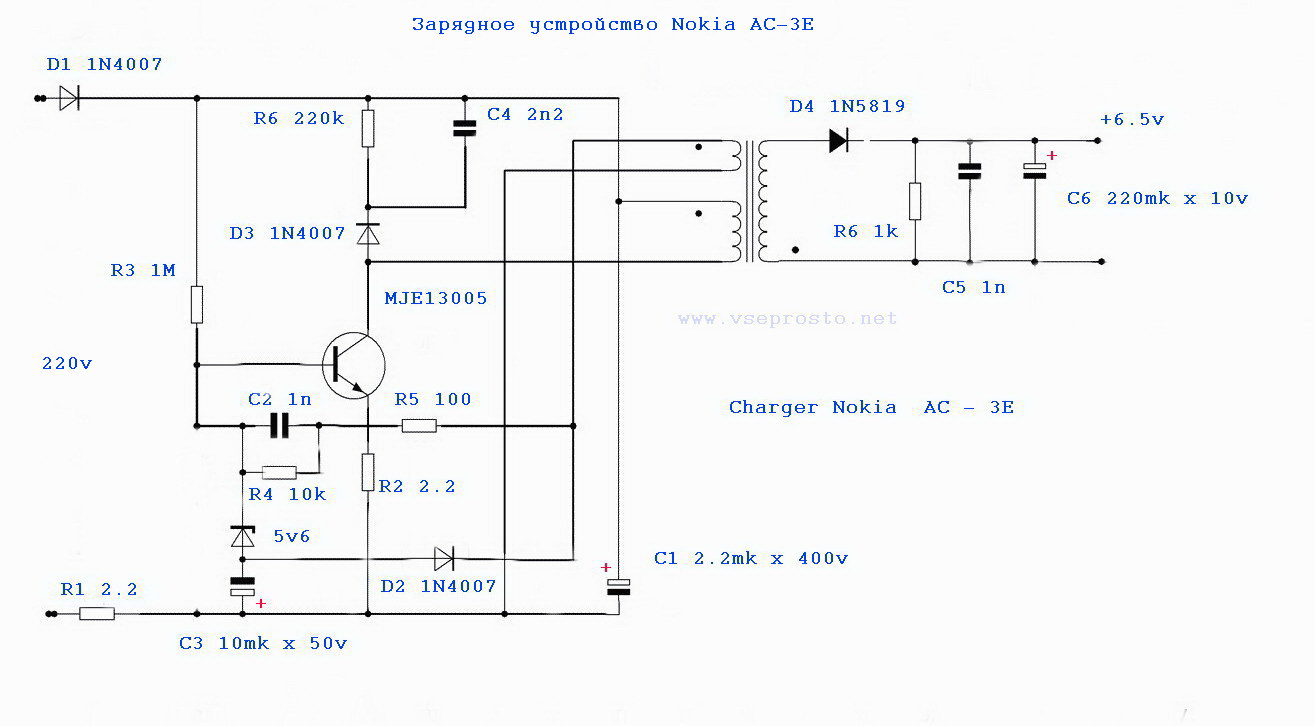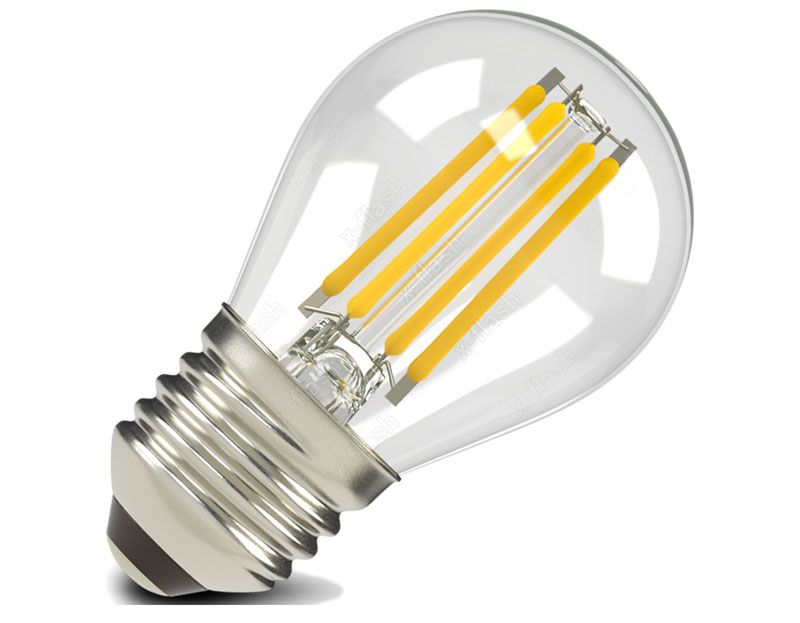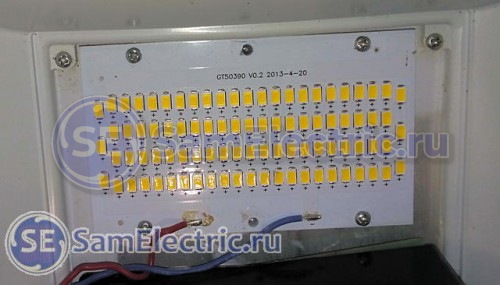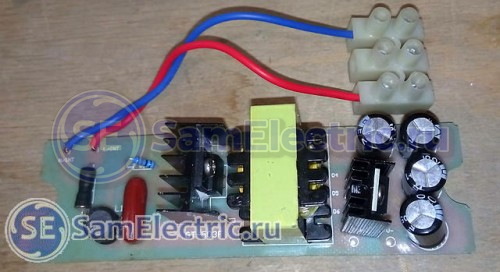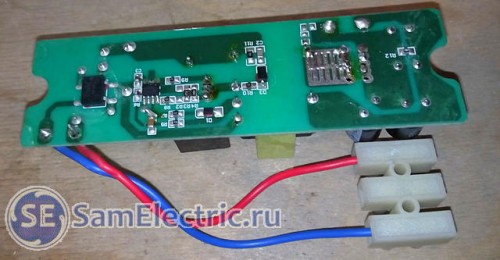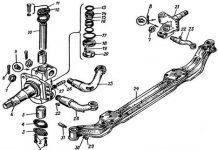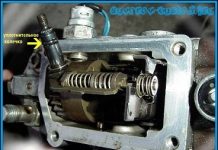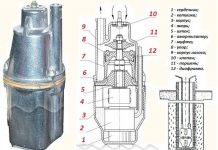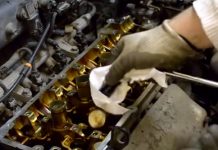In detail: DIY repair of LED drivers from a real master for the site my.housecope.com.
An LED driver is essentially a regular power supply designed for a certain load, in this case it is from 8 to 12 one-watt LEDs, and ideally supporting a certain current through the load. They brought such a driver for repair with a marking on the cover Led Driver QH (8-12) x1W
The driver did not turn on. An electrolytic capacitor of 47 microfarads at 50 volts is cut off. A similar defect is more common in units that have been in operation for a long time, but taking into account the penny cost of such electronics, and similarly poor quality, now such defects are not uncommon. This capacitor is worth a Chinese-made AM-22A PWM controller. I did not find analogs, but judging by the pinout, it can be replaced with more common controllers with a slight modification.
The input part of the power supply is typical, very similar to the circuit
mobile phone chargers. Diode, capacitor 6.8 microfarad x 400 volts, zener diode, Transistor 13001 which, in case of malfunction, easily changes to any other of this series with a higher power 13003 - 13007. After a voltage drop, the transistor and the low-resistance resistor acting as a fuse fail. Less commonly, a network capacitor.
At the output, a capacitor of 100 microfarads x 63 volts often dries out. A similar defect is expressed as a short flash of LEDs, or a complete failure to turn on the unit.
In the same way, a defect appears when the network capacitor 6.8 microfarads x 400 volts dries out. These usually have a swollen lid from overheating. In general, the temperature conditions of such devices are, to put it mildly, difficult. The tightly sealed case, no ventilation holes, does not add life to the device. So, if you want the driver to work for a long time, change all three electrolytic capacitors (47 microfarads x 25 volts including) and make at least a few holes in the case.
| Video (click to play). |
The voltage at the output of the working unit without load is about 40-45 volts.
There was a board of a similar driver assembled according to the simplest scheme, like this one:
The difference is mainly in the output voltage and some ratings.
The repair of such devices is described in more detail in the article - "Nokia AC-3E mobile phone charger - DIY repair.»
https://my.housecope.com/wp-content/uploads/ext/3597/2014/11/zaryadnoe-ustrojstvo-mobilnogo-telefona-nokia-ac-3e-remont-svoimi-rukami/
Analog PWM controller AM22A - DK112 - DK106 Despite the similarity of the scheme, VIPer22 is not analogous to AM22A.
A decade ago, such a rapid growth in the popularity of LED lighting for apartments and private houses was not expected. Today you will not meet a person who would not use these economical and bright lamps. The only problem remains in the cost of lighting fixtures - such fixtures cannot be called cheap. What if the lamp is out of order? Buy a new one? Not necessary. You can try to repair the lighting fixture. It is precisely the "device", because it is a complex technical device, in contrast to the "Ilyich's lamp". Today we will figure out how to repair LED lamps with our own hands and how difficult it is.
LEDs are the most economical type of lighting - it's hard to argue with that. Such elements are used both in everyday life and in production. Street lighting is gradually moving towards similar energy savings. Light diodes, in addition to efficiency, have another indisputable advantage over other types of lighting devices - they have no competitors in terms of durability. But they cannot work directly from a network with an alternating current of 220 V. This requires a special device called a driver.
The circuit of a 220 V LED lamp includes a device that is compact enough and fits in the base.There is nothing more complicated in the lighting device, however, the driver, performing work to stabilize the voltage, often fails. Burnt-out LEDs are not difficult to replace, it is enough to own a soldering iron at the "just learned" level. But today we will figure out how to repair drivers.
The general principle of operation of LED lamps is as follows. The alternating current of the network enters an electronic device - a driver that stabilizes voltage drops. Direct current is directed to LEDs, which emit the light we see.
Related article:
If we simplify such a system, we get a 220 V LED lamp driver circuit, which includes two damping resistors that stabilize the voltage. LEDs are connected in different directions, which protects against reverse voltage. The flicker frequency doubles - from 50 to 100 Hz.
Power in such a circuit is fed through a limiting capacitor to a rectifier (diode bridge), and only then to the elements. We simplify the system. We change one light diode to a rectifier. The lamp works, but the frequency of the current, instead of increasing, decreases by 2 times and becomes equal to 25 Hz, which leads to a sensitive flickering of the lighting fixture. It is harmful to vision, impairs health, increases fatigue and causes headaches.
However, there are LED lamps at a completely different cost. For example, GENILED SDL-KS 80W 07077, 80 W power and 4700K color temperature. Its cost can be surprising. It is equal to 10,200 rubles.
Often the reason for the failure of an LED lamp is improper operation or sudden voltage drops in the network. Let's take a look at the most common ones:
- A sharp power surge. LEDs in such a situation will remain intact, but the driver may fail;
- Wrong choice of luminaire. If normal ventilation is not provided, the driver overheats, which negatively affects its operation;
- Factory defect or falsification of products. If you come across a too cheap lamp of this type on the counter, you should think about how the low price was achieved;
- Vibration and shock. They are not terrible for LEDs, but for the driver they can be fatal.
Most often, the capacitor fails (the lamp will stop burning), and the current-limiting resistor (sensitive flickering, up to blinking). In order not to buy new equipment, you need to understand how to repair an LED lamp with your own hands.
The driver, which causes failure in 80% of cases, is not necessarily built into the light bulb. The light source can only consist of LEDs, and the stabilizing device will be built into the lamp or chandelier. However, the remaining 20% should not be discounted. It is necessary to check all the details before proceeding with the repair of the ice lamps.
In the case of a separate driver, everything is simpler. We change the lamp, and if it glows, then the problem is in it, if not, the stabilizer is to blame. The situation with the built-in driver is more complicated.
Now the promised secret. To repair LED lamps with an ordinary soldering iron, you need a piece of copper single-core wire, with a cross section of 4 mm², 10 ÷ 15 cm long. "Scapula". The temperature will also depend on the length. Convenient if the multimeter has a thermometer function. For LED SMD components, which are used in LED lamps, a temperature of 240 ÷ 260 ° C is required.
Some devices are not easy to disassemble. When you try to rotate the top, nothing comes out? Then a solvent comes in handy. We put it into a syringe and carefully pass through the needle along the seam. We leave for 5 minutes, after which we repeat the operation. Usually 2 ÷ 3 procedures are enough. Gently swing the upper part by turning left and right. After removing the cover, we clean off the old sealant and degrease the surfaces. If you plan to use the lamp in a dry environment, you do not need to apply new sealant.
Having figured out how to fix a 220V LED lamp, it makes sense to deal with more complex devices, such as spotlights or chandeliers. Although there is not much difference in the work. Experts say that repairing LED floodlights is even easier, because the drivers and their parts are larger. We subscribe to this opinion. It only seems that such devices are more high-tech and more complex. In fact, having diagrams at hand (they are always contained in the technical documentation of a lighting device), for example, repairing an LED chandelier is quite simple. The same continuity of LEDs, driver details. After - the selection of suitable ones to replace the burned ones.
Important information! If the LED burns out and there is no suitable replacement at hand, you can slightly extend the life of the lighting device. The contacts of the burned-out element are bridged among themselves, and the lamp lights up again. But you should be prepared for the fact that after a short time it will go out again. The LED next to the bridged one will light up. If you continue to install the jumpers, the time between repairs will decrease exponentially.
If all the LED lighting in the bathroom goes out at the same time, you should start small. Remove the switch cover and check the voltage supply. If everything is in order, then the problem is in the power supply.
A bathroom is a room with high humidity, in which the use of 220 volt lighting fixtures is unacceptable. For this reason, a 12 volt power supply is installed. The reason that all the lighting stopped burning at once may be the failure of this device or a breakdown of the wiring, which is hardly realistic. You will have to buy such a block. Having dismantled the old block, we look at the technical parameters, purchase a stabilizer with similar characteristics and install it in place.
Important! All work on dismantling and installation of the stabilizing power supply is carried out only with the voltage removed. It is better to turn off the introductory machine. This is the only way to protect yourself from electric shock.
This is a common problem. It happens that people refuse to replace ordinary lighting in an apartment with LED due to the fact that when the light is off, the LEDs blink, in the manner of a stroboscope. There is only one reason for this - the backlight of the switch.
If the indicator is on, it is passing a certain amount of electricity through it, which does not have any effect on conventional lamps. But in the driver of LED lighting devices there is a capacitor that has the ability to store electricity and then give it out. He then collects this energy "bit by bit", and upon reaching a certain volume gives it in the form of a pulse to the LEDs.
The problem can be solved very simply - turn off the backlight on the switch. However, blinking due to the indication on the key is a consequence. And what's the reason? There are also no difficulties here. The reason is the incorrect connection of the chandelier sockets. It is known that when incandescent lamps are installed, zero goes to the thread of the base, and the phase goes to the center.The LEDs start blinking if this order is violated and the wiring is done incorrectly.
LED lighting continues to grow in popularity. But even with a decrease in prices for lighting devices based on them, they remain expensive. And why overpay if you can repair a light bulb or lamp with your own hands. You don't even need to purchase parts for this. You just don’t need to throw out those that are out of order. Then from two or three it will be possible to collect one worker.
We hope the information presented in our article will help the reader to save money on the purchase of lighting equipment. If you have any questions, you can ask them in the discussion below. And finally, we suggest watching a useful video on the topic:
author
Light sources of this category are in great demand on the modern market. They consume a small amount of energy, are durable and resistant to various external influences. However, any technical device can fail during operation. A factory defect, which may appear after the end of the official warranty period, cannot be ruled out. Do-it-yourself qualified repair of LED lamps will help to fix the problem at no extra cost. This article provides technologies for restoring device operability at home with step-by-step instructions and explanations.
It should be noted right away that lamps with such LEDs (filament) cannot be repaired. In them, the flask is filled with an inert gas, and the manufacturers keep the exact composition secret. High-quality reproduction of industrial technology at home is impossible.
They are all made from standard, inexpensive LEDs that can be purchased easily. Typical tools are suitable for checking and performing work operations. The simplest special devices for dismantling and subsequent assembly can be made by hand.
It makes no sense to study physical processes in detail. Suffice it to say that in this case the light source is a specialized semiconductor device. It emits light when applied to a constant voltage of several volts at a relatively low current strength. This means that rectification and limitation of the corresponding electrical parameters will be required. The presence of a p-n junction indicates the possibility of clarifying the operability using a typical test of a conventional diode.
A driver is an electronic circuit that rectifies the voltage, limits the current to its nominal value. The required number of LEDs is installed on a substrate with a heat sink for heat dissipation. The diffuser eliminates irregularities in the luminous flux and excessive brightness of individual emitting elements.
In this simplest 220V LED lamp driver circuitry, capacitor C1 together with resistor R1 reduce the voltage to the desired value. It is determined by the number of LEDs connected in series. On each of them, the voltage drop is about 3 V (the exact value is indicated in the technical data sheet of the device). After the diode bridge, the remaining ripple is smoothed out by the capacitor C2. Resistors R3, R4 limit the inrush current when connected to the power supply. When the lamp turns off, the parallel capacitor is quickly discharged through R2.
In the circuit under consideration, the simplest electronic components are used that rarely fail. According to statistics, the most often damaged electrolytic smoothing capacitor. Problems arise if parts are used "sparingly" without a voltage margin.
Insufficient quality soldered joints are also encountered. They are destroyed after several on / off cycles as a result of thermal expansion / contraction.Repair of LED lamps may be needed more often if they are installed in a room with high humidity. In lamps of this type, there are no contact groups that are damaged by the formation of a film of oxides. Therefore, here, too, the cause of breakdown will be defective soldering.
Sometimes heat dissipation is poorly organized. Under such conditions, LEDs are unable to perform their functions for a long time. It is unacceptable if a plastic fake is installed instead of a metal radiator. It makes sense to repair such products only with a complete replacement of unusable parts of the structure. In case of incompetent assembly, they "save" thermal paste or do not use it at all. In this case, even a high-quality aluminum radiator will not perform its functions with maximum efficiency.
To eliminate doubts, check 220 V directly in the cartridge. To do this, use a multimeter, a phase probe (a screwdriver with a built-in phase indicator), or screw in another workable lamp.
LED Spotlight. DIY repair theory and practice.
LED floodlights are very popular today. But, like any electronics, spotlights break down relatively often.
Today's article will be devoted to the repair of LED floodlights with your own hands.
The entire theory and terminology for the device of LED floodlights is described in the previous article, and here is the practice for home craftsmen.
First of all, you need to make sure that 220 V power is supplied to the driver. This is Azy. Then it remains to decide what is faulty - the LED driver or the LED matrix.
Let me remind you that the word “driver” is a marketing ploy to designate a current source designed for a specific matrix with a specific current and power.
In order to check the driver without an LED (idle, no load), just apply 220V to its input. A constant voltage should appear at the output, a value slightly greater than the upper limit indicated on the block.
For example, if the range of 28-38 V is indicated on the driver unit, then when turned on, its idle output voltage will be approximately 40V. This is due to the principle of operation of the circuit - to maintain the current in a given range of ± 5%, with an increase in the load resistance (idle = infinity), the voltage must also increase. Naturally, not indefinitely, but up to a certain upper limit.
However, this test method does not allow us to judge the health of the LED driver by 100%.
The fact is that there are serviceable blocks that, when turned on without load, without load, either will not start at all, or will give out something incomprehensible.
I suggest connecting a load resistor to the output of the LED driver in order to provide it with the desired operating mode. How to choose a resistor - according to Uncle Ohm's law, looking at what is written on the driver.
LED - driver 20 W. Stable output current 600 mA, voltage 23-35 V.
For example, if Output 23-35 VDC 600 mA is written, then the resistance of the resistor will be from 23 / 0.6 = 38 Ohm to 35 / 0.6 = 58 Ohm. Choose from a range of resistances: 39, 43, 47, 51, 56 Ohm. The power must be adequate. But if you take 5 W, then it will be enough for a few seconds to check.
Attention! The driver output is usually galvanically isolated from the 220V network. However, you should be careful - there may not be a transformer in cheap circuits!
If, when connecting the required resistor, the output voltage is within the specified limits, we conclude that the LED driver is working properly.
For testing, you can use a laboratory power supply, something like this. We supply a voltage that is obviously lower than the nominal value. We control the current. The LED matrix should light up.
We control the current further and carefully increase the voltage so that the current reaches its nominal value. The matrix will glow at full brightness. We confirm that it is 100% serviceable.
There are situations where there is an LED chip, but its wattage, current, and voltage are unknown. Accordingly, it is difficult to buy it, and if it is in good working order, it is not clear how to choose an adapter.
This was a big problem for me until I figured it out. I am sharing with you how to determine by the appearance of the LED assembly what voltage, power and current it is.
For example, we have a spotlight with the following LED assembly:
9 diodes. 10 W, 300 mA. In fact - 9 W, but this is within the margin of error.
It gave the fact that diodes with a power of 1 W are used in the LED matrices of the floodlights. The current of such diodes is 300 ... 330 mA. Naturally, all this is approximately, within the margin of error, but in practice it works exactly.
In this matrix, 9 diodes are connected in series, their current is one (300 mA), and the voltage is 3 Volts. As a result, the total voltage is 3x9 = 27 volts. For such matrices, you need a driver with a current of 300 mA, a voltage of about 27V (usually from 20 to 36V). The power of one such diode, as I said, is about 9 watts, but for marketing purposes this floodlight will be at a power of 10 watts.
The 10 W example is a bit atypical due to the special arrangement of the LEDs.
Another example, more typical:
LED assembly for 20W floodlight
You have already guessed that two horizontal rows of dots of 10 pieces each are LEDs. One strip is offhand 30 Volts, current 300 mA. Two strips connected in parallel - voltage 30 V, current twice as much, 600 mA.
5 rows (zig-zag) of 10 LEDs.
Total - 50 W, current 300x5 = 1500 mA.
Matrix 7 rows of 10 LEDs
Total - 70 W, 300x7 = 2100 mA.
I think it makes no sense to continue, everything is already clear.
It's a little different with LED modules based on discrete diodes. According to my calculations, one diode there, as a rule, has a power of 0.5 watts. Here is an example of a GT50390 matrix installed in a 50W floodlight:
Navigator LED floodlight, 50 W. GT50390 LED Module - 90 Discrete Diodes
If, according to my assumptions, the power of such diodes is 0.5 W, then the power of the entire module should be 45 W. Its circuit will be the same, 9 lines of 10 diodes with a total voltage of about 30 V. The operating current of one diode is 150 ... 170 mA, the total current of the module is 1350 ... 1500.
Who has other thoughts on this matter - you are welcome in the comments!
It is better to start repairs by looking for an electrical circuit of the Led driver.
Typically, LED floodlight drivers are built on the MT7930 ASIC. In the article about the Device of searchlights, I gave a photo of the board (non-waterproof) based on this microcircuit, again:
Navigator LED floodlight, 50 W. Driver. GT503F board
Navigator LED floodlight, 50 W. Driver. Soldering side view
Attention! Information on driver circuits and a little more on repair is in a separate article!
There are no special tricks when replacing the LED matrix, but you need to pay attention to the following things.
- carefully remove old heat transfer paste,
- apply heat transfer paste to the new LED. It is best to do this with a plastic card,
- fix the diode evenly, without distortions,
- remove excess paste,
- do not mix up the polarity,
- do not overheat when soldering.
The reverse side of the LED matrix, on which the heat-conducting paste is applied during installation
When repairing an LED module consisting of discrete diodes, first of all, you need to pay attention to the integrity of the soldering. And then check each diode by supplying it with a voltage of 2.3 - 2.8 V.
If you need quick repairs, then it is best, of course, to run to the store across the street.
But if you are engaged in renovation on an ongoing basis, then it is better to look where it is cheaper. I recommend doing this on the well-known Aliexpress website.
This concludes. I call on my colleagues to share their experience and ask questions!
Hello. Thanks for the scheme, I have been looking for it for a long time, but it was all wrong. How many matrices I put with aliexpress, everything burned out in about a month. The reason for this is the poor quality of the matrices themselves. For example, a 50-watt matrix, a current consumption of 1.3 amperes, a voltage of 37-38 volts, received about 50 watts. But the temperature on the matrix installed in the floodlight reaches 93 degrees, which is critical. The result is deplorable in a month. ... For treatment, I reduce the current to 0.9-1 amperes, the temperature drops to 70 degrees, this is already normal.
Yes, you need to read the reviews carefully before buying. And do not chase cheap prices.
Alexey, in what way do you reduce the current? Is in the driver or is there a resistor in series?
A resistor in series, is it a 50-watt one?
And we recently bought a spotlight, everything is wired into one chip, there is no separate driver. I took it only because I didn't want unnecessary problems with driver breakdowns. Glanzen spotlights seem to be, but I don't remember exactly.
That is, a monolith with a diode is connected to 220, and that's it?
It looks like there are RGB LEDs with a built-in chip that smoothly switches three colors. In appearance and size, it is an ordinary two-pin white LED.
Yes, there are LED matrices
220v.
For example
Here's another,
LED technology is developing dynamically. For example, recently two Korean companies - LEDStudio and POWERLIGHTEC - have released new LEDs with a built-in current stabilization driver and a zener diode.
This solution eliminates the need to stabilize the input supply current. The LED performs this operation itself. The input voltage of this LED is 11-18V, which makes it possible to use them, for example, in car headlights.
Why not.
The zener diode must be powerful and connected in series with the LED matrix.
The driver did not have to be repaired yet, so I wanted to find out if something in the driver's circuit burns when the fuse blows? At work, you often have to deal with burnt out electronic ballasts. They usually burn transistors and their strapping, although there are fuse resistors in the strapping to protect the transistors. It seems that the fuse burns out (not always!) After the transistors burn out; logically, it should be the other way around.
Typically transistors and diode bridges.
Also, with voltage surges, the microcircuit may burn out.
It's clear. In general, such devices as in the first diagram need to be refined, varistors (as in the second diagram) or suppressors and ... a fuse must be installed, otherwise it was at work, I found a couple of devices (thermostat and time relay) with burnt out varistors and UPS, i.e. e. the protection was on, but there were no fuses inside. Apparently the manufacturers are designed for an external fuse or an automatic device (so that they do not climb inside!), But who installed these devices did not know.
I regulate the current by removing the resistor in the piping of the microcircuit, usually I limit myself to one, the power drops from 50 to 30 watts, each matrix has a different consumption current.
Is it the resistors Rs which are from the source of the transistor?
With a variety of lighting devices on the counters of the country, LEDs remain out of competition due to their efficiency and durability. However, a high-quality product is not always purchased, because in a store you cannot disassemble the goods for inspection. And in this case, it is not a fact that everyone will determine from what parts it is assembled. Lamps burn out, and it becomes expensive to buy new ones. The solution is to repair LED lamps with your own hands. This work is within the power of even a novice home craftsman, and the details are inexpensive. Today we will figure out how to check the lighting device, in what cases the product is repaired and how to do it.
It is known that LEDs cannot work directly from a 220 V network. To do this, they need additional equipment, which, most often, fails. We will talk about him today. Consider the circuit of an LED driver, without which the operation of the lighting device is impossible. Along the way, we will conduct an educational program for those who do not understand anything in electronics.
The 220V LED lamp driver circuit consists of:
- diode bridge;
- resistances;
- resistors.
The diode bridge serves to rectify the current (converting it from alternating to direct current). On the graph, this looks like a cut-off of a half-wave of a sine wave. Resistances limit current, and capacitors store energy by increasing the frequency. Consider the principle of operation on the circuit of a 220 V LED lamp.
Having understood the principle of operation and the driver circuit, the decision on how to fix a 220V LED lamp will no longer seem difficult. If we talk about high-quality lighting devices, then you should not expect trouble from them. They work for the entire prescribed period and do not fade, although there are "diseases" to which they are also susceptible. Let's talk about how to deal with them.
To make it easier to understand the reasons, we summarize all the data in one common table.
Good to know! Repair of LED fixtures is impossible to carry out indefinitely. It is much easier to eliminate negative factors affecting durability and not to purchase cheap products. Savings today will cost you tomorrow. As economist Adam Smith said, "I'm not rich enough to buy cheap things."
Before you repair an LED lamp with your own hands, pay attention to some details that require less labor. Checking the cartridge and the voltage in it is the first thing to do.
Important! Repair of LED lamps requires a multimeter - without it, it will not be possible to ring the driver elements. A soldering station is also required.
A soldering station is required for the repair of LED chandeliers and lighting fixtures. After all, overheating of their elements leads to failure. The heating temperature during soldering should be no higher than 2600, while the soldering iron heats up more. But there is a way out. We use a piece of copper core with a cross section of 4 mm, which is wound around the tip of the soldering iron with a tight spiral. The more you lengthen the sting, the lower its temperature. Convenient if the multimeter has a thermometer function. In this case, it can be adjusted more precisely.
But before you repair LED spotlights, chandeliers or lamps, you need to determine the cause of the failure.
One of the problems that a novice home craftsman faces is how to disassemble an LED light bulb. To do this, you need an awl, solvent and a syringe with a needle. The diffuser of the LED lamp is glued to the body with a sealant that must be removed. Passing carefully along the edge of the diffuser with an awl, inject the solvent with a syringe. After 2 ÷ 3 minutes, lightly twisting, the diffuser is removed.
Some lighting fixtures are made without gluing with a sealant. In this case, it is enough to turn the diffuser and remove it from the housing.
Having disassembled the lighting fixture, pay attention to the LED elements. Burned is often identified visually: there are burn marks or black dots on it. Then we change the faulty part and check the functionality. We will describe the replacement in detail in the step-by-step instructions.
If the LED elements are in order, go to the driver. To check the performance of its parts, you need to solder them from the printed circuit board. The value of the resistors (resistances) is indicated on the board, and the parameters of the capacitor are indicated on the case. When dialing with a multimeter in the appropriate modes, there should be no deviations. However, often failed capacitors are determined visually - they swell or burst. The solution is to replace it with a suitable one in terms of technical parameters.
Replacing capacitors and resistances, unlike LEDs, is often performed with a conventional soldering iron. In this case, you should be careful not to overheat the nearest contacts and elements.
If you have a soldering station or a hair dryer, this job is simple. It is more difficult to work with a soldering iron, but it is also possible.
Good to know! If there are no working LED elements at hand, you can install a jumper instead of the burnt one. Such a lamp will not work for a long time, but it will be possible to win some time. However, such repairs are made only if the number of elements is more than six. Otherwise, the day is the maximum work of the repair product.
Modern lamps run on SMD LED elements that can be soldered out of an LED strip. But it is worth choosing those that are suitable for technical characteristics. If there are none, it is better to change everything.
Related article:
If the driver consists of smaller SMD components, use a copper wire soldering iron on the tip. A visual inspection revealed a burnt element - we solder it and select the one that matches the marking. No visible damage is more difficult. We'll have to solder all the details and ring them separately. Having found the burnt one, we change it to a workable one and mount the elements in place. It is convenient to use tweezers for this.
Useful advice! Do not remove all elements from the PCB at the same time. They are similar in appearance, you can later confuse the location. It is better to solder the elements one at a time and, after checking, mount them in place.
When installing lighting in rooms with high humidity (bathroom or kitchen), stabilizing power supplies are used, which lower the voltage to a safe one (12 or 24 volts). The stabilizer can fail for several reasons. The main ones are excessive load (power consumption of the luminaires) or the wrong choice of the degree of protection of the unit. Such devices are repaired in specialized services. At home, this is unrealistic without the availability of equipment and knowledge in the field of radio electronics. In this case, the power supply unit will have to be replaced.
Very important! All work on replacing the stabilizing LED power supply is carried out with the voltage removed. Do not rely on the switch - it may be incorrectly wired. The voltage is disconnected in the distribution board of the apartment. Remember that touching live parts with your hand is life-threatening.
You need to pay attention to the technical characteristics of the device - the power must exceed the parameters of the lamps that are powered from it. Having disconnected the failed unit, we connect a new one according to the diagram. It can be found in the technical documentation of the device. This is not difficult - all wires are color-coded, and the contacts are letter designation.
Plays the role and degree of protection of the device (IP). For a bathroom, the device must be marked at least IP45.
Related article:
If the reason for the flickering of the LED lamp is the failure of the capacitor (it needs to be replaced), then periodic blinking when the light is off is easier to solve. The reason for this "behavior" of the luminaire is the backlight-indicator on the switch key.
The capacitor located in the driver circuit accumulates voltage, and when the limit is reached, it gives out a discharge. The key backlight transmits a small amount of electricity, which does not in any way affect incandescent bulbs or "halogens", but this voltage is enough for the capacitor to start accumulating it. At a certain moment, it gives out a discharge to the LEDs, after which it switches back to accumulation. There are two ways to solve this problem:
- We take out the key from the switch and turn off the backlight.The method is simple, but indications that add value to the switch are no longer useful.
- We disassemble the chandelier and change the phase wire with zero places on each cartridge. The method is more complicated, but it retains the functionality of the switch. In the dark, you can see it well, and this is a plus.
Not only LED lamps, but also CFLs are susceptible to flashing. The device of their PRU (starting-regulating device) works on a similar principle, which allows the capacitor to store energy.
| Video (click to play). |
Consider an example of a simple LED lamp repair:

